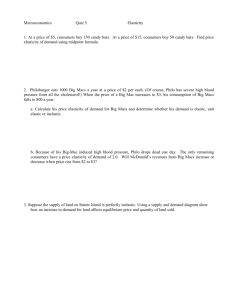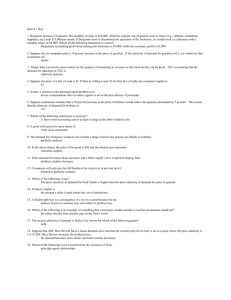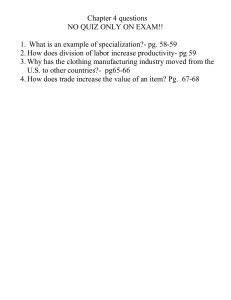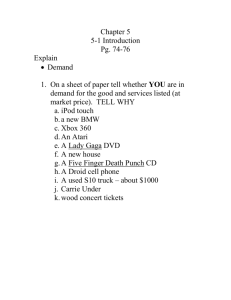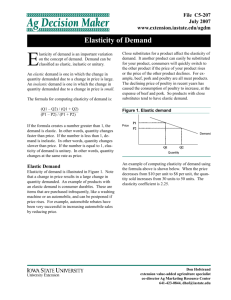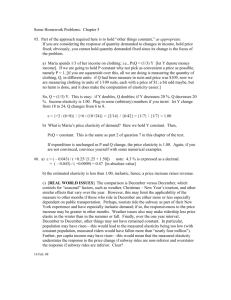Chapter 5 Mankiw Macro
advertisement
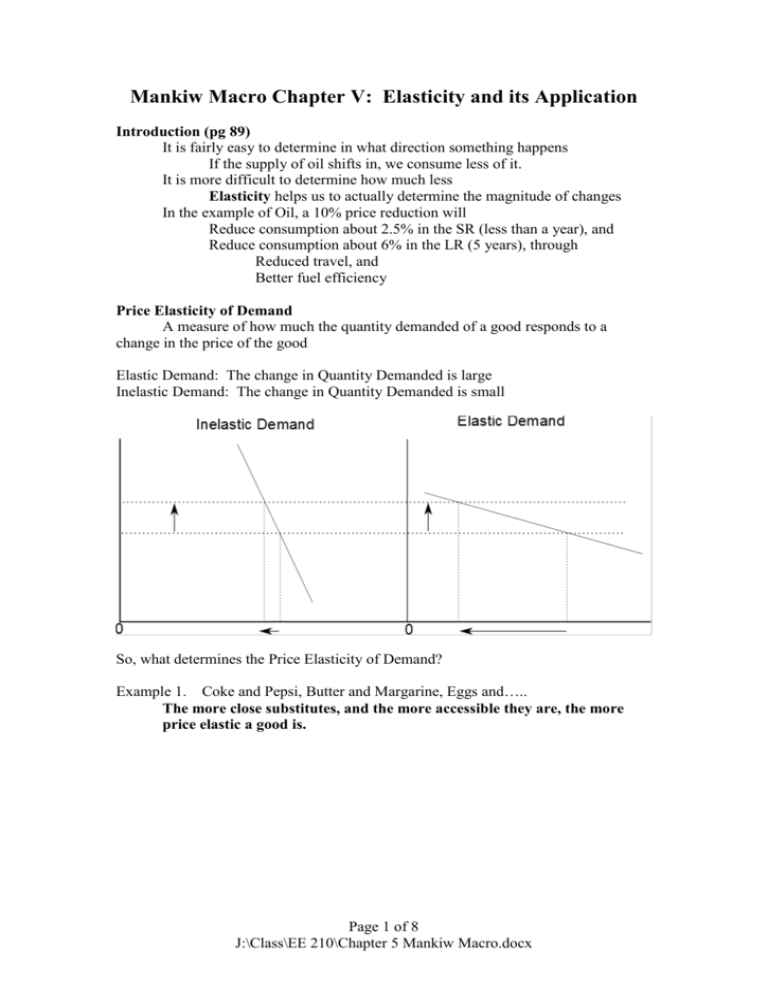
Mankiw Macro Chapter V: Elasticity and its Application Introduction (pg 89) It is fairly easy to determine in what direction something happens If the supply of oil shifts in, we consume less of it. It is more difficult to determine how much less Elasticity helps us to actually determine the magnitude of changes In the example of Oil, a 10% price reduction will Reduce consumption about 2.5% in the SR (less than a year), and Reduce consumption about 6% in the LR (5 years), through Reduced travel, and Better fuel efficiency Price Elasticity of Demand A measure of how much the quantity demanded of a good responds to a change in the price of the good Elastic Demand: The change in Quantity Demanded is large Inelastic Demand: The change in Quantity Demanded is small So, what determines the Price Elasticity of Demand? Example 1. Coke and Pepsi, Butter and Margarine, Eggs and….. The more close substitutes, and the more accessible they are, the more price elastic a good is. Page 1 of 8 J:\Class\EE 210\Chapter 5 Mankiw Macro.docx Example 2. Food vs. Travel “Necessities” tend to have an inelastic demand, while luxuries have a more elastic demand. (how people define necessities varies however….) Example 3. Food vs. Japanese food, vs. Sushi, vs. Sashimi, vs. Fugu The narrower our definition of a market, the more inelastic the demand, but as we broaden our definition of the market, demand becomes more elastic. Page 2 of 8 J:\Class\EE 210\Chapter 5 Mankiw Macro.docx Example 4. Gasoline, (or energy….?) (Counter-example: short term food costs…) The shorter the time horizon, the less elastic demand will be. With more time, people can adjust to higher/lower prices, and price elasticity will increase. Computing Price elasticity. (pg 91) Price Elasticity of Demand PEd = %change Qd / %change in P This is not actually a constant, it depends on where we start….. Price of Sushi 100 80 60 40 20 Quantity Demanded 1 2 3 4 5 FOR OUR PURPOSES, WE WILL HAVE THREE SORTS OF GOODS…. INELASTIC, ELASTIC, NORMAL Page 3 of 8 J:\Class\EE 210\Chapter 5 Mankiw Macro.docx Other Demand Elasticities (Pg 97) Income Elasticity of Demand How much does demand shift if income goes up or down? Normal goods have a positive income elasticity (Qd rises with Income), Inferior goods have a negative income elasticity (Qd falls as income rises). We model this as how much does the demand curve shift as income rises/falls Example: Mama and Sushi Cross price Elasticity of Demand: How much does demand shift if the price of another good changes? Is the change positive (Substitutes) or negative (complements). Example: Hot dogs and burgers, hot dogs and ketchup Page 4 of 8 J:\Class\EE 210\Chapter 5 Mankiw Macro.docx O.K. APPLICATIONS….. Elasticity and Total Revenue…. Total revenue is simply the quantity sold, times the price. What happens to total revenue when you increase price on an elastic good An Inelastic Good? Example: Vaping and protecting people from the dangers of cigarettes Page 5 of 8 J:\Class\EE 210\Chapter 5 Mankiw Macro.docx The Elasticity of Supply (price elasticity of supply) pg 98 Calculating it is similar to how you would do so for demand… You don’t need to know how to. As with demand, we will have 3 different Price Elasticity of Supply, Elastic, Inelastic, Normal. Page 6 of 8 J:\Class\EE 210\Chapter 5 Mankiw Macro.docx Example 1. Why do farmers pray for bad weather? Example 2. OPEC and the price of Oil. Page 7 of 8 J:\Class\EE 210\Chapter 5 Mankiw Macro.docx Example 3. The War on Drugs Page 8 of 8 J:\Class\EE 210\Chapter 5 Mankiw Macro.docx



